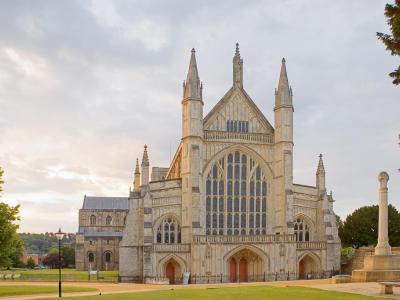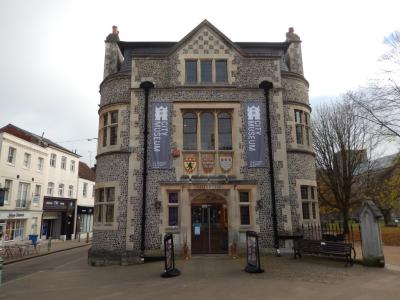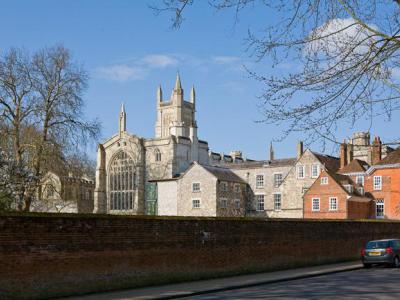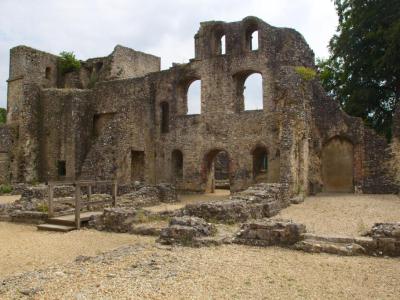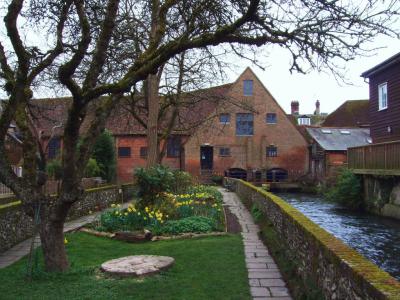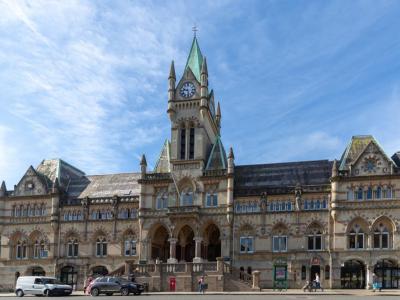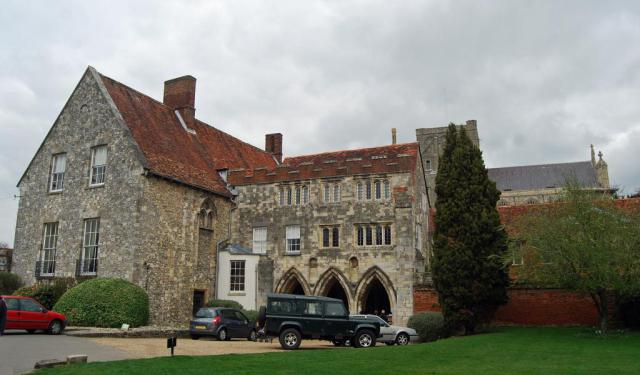
Winchester Introduction Walking Tour (Self Guided), Winchester
Winchester, the county town of Hampshire, England, is a charming place with a great deal of history.
The name, Winchester, is traced back to its Old English origins, derived from "Wintan-ceaster" which means "Fort Venta". The city itself emerged in Roman times when it was known as Venta Belgarum, in which Venta was a common Celtic word for a "tribal town" or "meeting place" and Belgarum referred to the local tribe, the Belgae, who inhabited the area since the Iron Age.
During the Anglo-Saxon period, until the 13th century, Winchester served as the capital of England. In fact, the country had no fixed capital as such at that time, and the royal court was mobile. The proverb, "In the land of the blind, the one-eyed man is king", is loosely attributed to Winchester's role as one of the country's "proto-capitals" back then (alongside London).
One of England's top tourist attractions, the famous Winchester Cathedral, was renovated several times in the 9th and 10th centuries and it was here that William the Conqueror had himself crowned.
Winchester College, one of the oldest schools in the country, showcases the city's commitment to education. Its picturesque buildings and well-manicured grounds attest to its centuries-old tradition of academic excellence.
Wolvesey Castle, also known as the Old Bishop's Palace, offers visitors a glimpse into medieval life. This historic site provides a window into the power and influence of the bishops who once resided here.
Also adding largely to the list of fun things to do in Winchester is visiting the local museums. For those with an interest in history, the Winchester City Museum is a must, chronicling the city's past from its Roman roots to the present day. At the same time, Jane Austen's Last Home offers a glimpse into the life of the beloved author during her final days. And of course, history enthusiasts will be captivated by Winchester's Military Museums.
Finally, the Great Hall of Winchester Castle, housing the legendary Round Table of King Arthur, adds a touch of myth and legend to the city's yesteryear. Some say King Arthur drew the sword Excalibur from the stone in which it was buried, and thus Winchester became his Camelot.
Winchester's historical significance is palpable as one explores its well-preserved landmarks and treasured ruins. This beautiful city invites you to step back in time and offers a truly memorable experience for those who go for it. Don't miss the opportunity and do it too!
The name, Winchester, is traced back to its Old English origins, derived from "Wintan-ceaster" which means "Fort Venta". The city itself emerged in Roman times when it was known as Venta Belgarum, in which Venta was a common Celtic word for a "tribal town" or "meeting place" and Belgarum referred to the local tribe, the Belgae, who inhabited the area since the Iron Age.
During the Anglo-Saxon period, until the 13th century, Winchester served as the capital of England. In fact, the country had no fixed capital as such at that time, and the royal court was mobile. The proverb, "In the land of the blind, the one-eyed man is king", is loosely attributed to Winchester's role as one of the country's "proto-capitals" back then (alongside London).
One of England's top tourist attractions, the famous Winchester Cathedral, was renovated several times in the 9th and 10th centuries and it was here that William the Conqueror had himself crowned.
Winchester College, one of the oldest schools in the country, showcases the city's commitment to education. Its picturesque buildings and well-manicured grounds attest to its centuries-old tradition of academic excellence.
Wolvesey Castle, also known as the Old Bishop's Palace, offers visitors a glimpse into medieval life. This historic site provides a window into the power and influence of the bishops who once resided here.
Also adding largely to the list of fun things to do in Winchester is visiting the local museums. For those with an interest in history, the Winchester City Museum is a must, chronicling the city's past from its Roman roots to the present day. At the same time, Jane Austen's Last Home offers a glimpse into the life of the beloved author during her final days. And of course, history enthusiasts will be captivated by Winchester's Military Museums.
Finally, the Great Hall of Winchester Castle, housing the legendary Round Table of King Arthur, adds a touch of myth and legend to the city's yesteryear. Some say King Arthur drew the sword Excalibur from the stone in which it was buried, and thus Winchester became his Camelot.
Winchester's historical significance is palpable as one explores its well-preserved landmarks and treasured ruins. This beautiful city invites you to step back in time and offers a truly memorable experience for those who go for it. Don't miss the opportunity and do it too!
How it works: Download the app "GPSmyCity: Walks in 1K+ Cities" from Apple App Store or Google Play Store to your mobile phone or tablet. The app turns your mobile device into a personal tour guide and its built-in GPS navigation functions guide you from one tour stop to next. The app works offline, so no data plan is needed when traveling abroad.
Winchester Introduction Walking Tour Map
Guide Name: Winchester Introduction Walking Tour
Guide Location: England » Winchester (See other walking tours in Winchester)
Guide Type: Self-guided Walking Tour (Sightseeing)
# of Attractions: 10
Tour Duration: 2 Hour(s)
Travel Distance: 3.7 Km or 2.3 Miles
Author: nataly
Sight(s) Featured in This Guide:
Guide Location: England » Winchester (See other walking tours in Winchester)
Guide Type: Self-guided Walking Tour (Sightseeing)
# of Attractions: 10
Tour Duration: 2 Hour(s)
Travel Distance: 3.7 Km or 2.3 Miles
Author: nataly
Sight(s) Featured in This Guide:
- Winchester Cathedral
- Winchester City Museum
- Jane Austen’s Last Home
- Winchester College
- Wolvesey Castle
- Winchester City Mill
- High Street
- Winchester Guildhall
- Winchester's Military Museums
- The Great Hall of Winchester Castle
1) Winchester Cathedral (must see)
Winchester Cathedral, formally known as the Cathedral Church of the Holy Trinity, Saint Peter, Saint Paul, and Saint Swithun, stands among the grandest cathedrals in Northern Europe. Serving as the seat of the Bishop of Winchester, it represents the ecclesiastical heart of the ancient Diocese of Winchester.
The cathedral, spanning from 1079 to 1532, honors numerous saints, particularly Saint Swithun of Winchester, and presents an impressive array of architectural styles, showcasing Norman transepts, an Early English retrochoir, and a Perpendicular Gothic style in its extensive nave. Its length spans an impressive 558 feet, marking it as the longest medieval cathedral globally, surpassed only by more recent constructions like Saint Peter's Basilica in Rome.
Built from a variety of stones—such as Quarr limestone from the Isle of Wight, Bath stone or Oolite, Caen stone from Normandy, ashlar, Beer stone, and Purbeck Marble—the cathedral displays the evolution of architectural styles. The structure's design includes a cruciform plan, featuring an extensive nave, transepts, central tower, choir, presbytery, and lady chapel.
The building incorporates significant sections constructed during the 11th century, notably the north and south transepts erected between 1079 and 1098 under Bishop Walkelin. The central tower, reconstructed in the Norman style post its collapse in 1107, offers insights hinting at its original intention for a grander structure, reflected in its elaborate interior features. The nave, initially completed between c.1100 and c.1129, underwent a Perpendicular Gothic remodeling from 1346 to 1420 while retaining much of the original Norman work.
Underneath the cathedral lies the extensive Norman-built crypt, featuring a notable statue by Antony Gormley and frequently facing winter flooding due to a high water table.
In contemporary times, the cathedral attracts numerous tourists due to its connection with Jane Austen, who passed away in Winchester on July 18, 1817. The cathedral served as the venue for her funeral, and her final resting place is in the north aisle.
The cathedral, spanning from 1079 to 1532, honors numerous saints, particularly Saint Swithun of Winchester, and presents an impressive array of architectural styles, showcasing Norman transepts, an Early English retrochoir, and a Perpendicular Gothic style in its extensive nave. Its length spans an impressive 558 feet, marking it as the longest medieval cathedral globally, surpassed only by more recent constructions like Saint Peter's Basilica in Rome.
Built from a variety of stones—such as Quarr limestone from the Isle of Wight, Bath stone or Oolite, Caen stone from Normandy, ashlar, Beer stone, and Purbeck Marble—the cathedral displays the evolution of architectural styles. The structure's design includes a cruciform plan, featuring an extensive nave, transepts, central tower, choir, presbytery, and lady chapel.
The building incorporates significant sections constructed during the 11th century, notably the north and south transepts erected between 1079 and 1098 under Bishop Walkelin. The central tower, reconstructed in the Norman style post its collapse in 1107, offers insights hinting at its original intention for a grander structure, reflected in its elaborate interior features. The nave, initially completed between c.1100 and c.1129, underwent a Perpendicular Gothic remodeling from 1346 to 1420 while retaining much of the original Norman work.
Underneath the cathedral lies the extensive Norman-built crypt, featuring a notable statue by Antony Gormley and frequently facing winter flooding due to a high water table.
In contemporary times, the cathedral attracts numerous tourists due to its connection with Jane Austen, who passed away in Winchester on July 18, 1817. The cathedral served as the venue for her funeral, and her final resting place is in the north aisle.
2) Winchester City Museum
Winchester City Museum stands as a vibrant testament to the historical tapestry of Winchester, unfolding its narrative from the Iron Age to the contemporary era. Spanning three floors, the museum's immersive galleries invite visitors to traverse the corridors of time and explore the captivating chapters that have shaped the city's identity.
The Roman treasures on display transport visitors to an era of opulence, showcasing intricate mosaics that speak to the grandeur of Roman Winchester. The allure continues with a curated collection of Anglo-Saxon jewelry, offering a glimpse into the craftsmanship and aesthetics of a bygone era.
A highlight of the museum is a meticulous model portraying the medieval settlement, providing a visual narrative of Winchester's early roots. Step into the Victorian era through faithfully reconstructed shops, offering a window into daily life during this transformative period.
The museum isn't confined to the past; it actively engages visitors with hands-on activities. From the tactile experience of brass rubbing to the creative exploration of pot design, visitors are invited to immerse themselves in the historical journey. The opportunity to don period costumes adds a playful touch to the interactive experience.
Among the treasures housed in the museum are artifacts once belonging to Jane Austen, the celebrated author who spent her final years in Winchester. These personal items offer an intimate connection to the renowned writer and add a literary dimension to the museum's eclectic tapestry.
From the grandeur of ancient civilizations to the intimate relics of literary figures, the museum weaves a narrative that transcends time, inviting visitors to become part of Winchester's enduring story.
The Roman treasures on display transport visitors to an era of opulence, showcasing intricate mosaics that speak to the grandeur of Roman Winchester. The allure continues with a curated collection of Anglo-Saxon jewelry, offering a glimpse into the craftsmanship and aesthetics of a bygone era.
A highlight of the museum is a meticulous model portraying the medieval settlement, providing a visual narrative of Winchester's early roots. Step into the Victorian era through faithfully reconstructed shops, offering a window into daily life during this transformative period.
The museum isn't confined to the past; it actively engages visitors with hands-on activities. From the tactile experience of brass rubbing to the creative exploration of pot design, visitors are invited to immerse themselves in the historical journey. The opportunity to don period costumes adds a playful touch to the interactive experience.
Among the treasures housed in the museum are artifacts once belonging to Jane Austen, the celebrated author who spent her final years in Winchester. These personal items offer an intimate connection to the renowned writer and add a literary dimension to the museum's eclectic tapestry.
From the grandeur of ancient civilizations to the intimate relics of literary figures, the museum weaves a narrative that transcends time, inviting visitors to become part of Winchester's enduring story.
3) Jane Austen’s Last Home
Jane Austen's Last Home in Winchester holds a poignant chapter in the life of the beloved author. During the final six weeks of her life, Austen resided in this house, where she peacefully passed away on July 17, 1817. Her resting place is nearby, within the hallowed grounds of Winchester Cathedral.
Born in Steventon, Hampshire, in 1775, Austen experienced various locales as an adult, including Bath and Southampton. Her move to Winchester was prompted by the pursuit of treatment for the illness that ultimately claimed her life.
Renowned for her literary prowess, Austen is immortalized for her six major novels, each a classic in English literature. The celebrated works include "Sense and Sensibility" (1811), "Pride and Prejudice" (1813), "Mansfield Park" (1814), "Emma" (1815), "Northanger Abbey" (1818, posthumous), and "Persuasion" (1818, posthumous).
Although Jane Austen's Last Home remains privately owned and is not open to visitors, a commemorative plaque marks its significance. Austen enthusiasts often make a pilgrimage to this spot, absorbing the aura of literary history, before or after paying respects at her final resting place in Winchester Cathedral.
Born in Steventon, Hampshire, in 1775, Austen experienced various locales as an adult, including Bath and Southampton. Her move to Winchester was prompted by the pursuit of treatment for the illness that ultimately claimed her life.
Renowned for her literary prowess, Austen is immortalized for her six major novels, each a classic in English literature. The celebrated works include "Sense and Sensibility" (1811), "Pride and Prejudice" (1813), "Mansfield Park" (1814), "Emma" (1815), "Northanger Abbey" (1818, posthumous), and "Persuasion" (1818, posthumous).
Although Jane Austen's Last Home remains privately owned and is not open to visitors, a commemorative plaque marks its significance. Austen enthusiasts often make a pilgrimage to this spot, absorbing the aura of literary history, before or after paying respects at her final resting place in Winchester Cathedral.
4) Winchester College (must see)
Founded in 1382, Winchester College stands as a venerable institution with deep ties to the historic city of Oxford. A visit to this distinguished school offers a glimpse into its rich history, with a particular focus on its original houses and architectural treasures.
Flint Court and Chamber Court, both immaculately preserved, showcase the enduring charm of Winchester College. Of special note is the Seventh Chamber, hailed as the oldest schoolroom in the country, bearing witness to centuries of academic pursuits within its walls.
The school chapel emerges as another highlight, boasting an original fan-vaulted timber roof and medieval stained glass that transports visitors to a bygone era. The reredos from 1500 adds to the chapel's historical allure, while the misericords provide intricate glimpses into the craftsmanship of the past. The cloisters, adorned with the engraved names of generations of scholars, including the renowned Anthony Trollope (1815-1882), serve as a testament to the enduring legacy of Winchester College.
Despite its age, Winchester College remains an active educational institution, and visitors are encouraged to partake in guided tours to fully appreciate its architectural and historical significance. These tours extend to the Winchester College Treasury, a repository of impressive artworks and antiquities that further enrich the visitor's experience.
Flint Court and Chamber Court, both immaculately preserved, showcase the enduring charm of Winchester College. Of special note is the Seventh Chamber, hailed as the oldest schoolroom in the country, bearing witness to centuries of academic pursuits within its walls.
The school chapel emerges as another highlight, boasting an original fan-vaulted timber roof and medieval stained glass that transports visitors to a bygone era. The reredos from 1500 adds to the chapel's historical allure, while the misericords provide intricate glimpses into the craftsmanship of the past. The cloisters, adorned with the engraved names of generations of scholars, including the renowned Anthony Trollope (1815-1882), serve as a testament to the enduring legacy of Winchester College.
Despite its age, Winchester College remains an active educational institution, and visitors are encouraged to partake in guided tours to fully appreciate its architectural and historical significance. These tours extend to the Winchester College Treasury, a repository of impressive artworks and antiquities that further enrich the visitor's experience.
5) Wolvesey Castle (must see)
Wolvesey Castle, also known as the "Old Bishop's Palace," stands as a historic ruin initially constructed as the official residence of Æthelwold of Winchester, the Bishop of Winchester, around 970. The building site, initially an eyot in the River Itchen, known as Wulveseye or Wulf's island, became the foundation for this bishop's palace. Henry of Blois, the Bishop of Winchester, expanded and developed the castle primarily between 1135 and 1171.
The castle's varied history includes construction modifications and, in 1684, a new palace in the baroque style was built to the south. However, much of it was later demolished, leaving only the west wing. Over time, the remaining structure found itself repurposed for various uses. Subsequent restoration efforts in 1926 refurbished part of the structure for the bishop's residence.
The chapel, an essential part of the medieval castle's south range, remains intact and is still in active use, attached to the palace. The extensive ruins are currently under the care and ownership of English Heritage and have held Grade I listed status since March 24, 1950. While sections of the curtain wall remain, much of the castle's internal structures are gone, although traces of the hall, displaying a well-preserved round arch and a surviving Norman window, can still be identified.
Situated close to the city walls, some sections of which are still standing, Wolvesey Castle stands as a fascinating piece of Winchester's history, illustrating a compelling narrative of the region's past.
The castle's varied history includes construction modifications and, in 1684, a new palace in the baroque style was built to the south. However, much of it was later demolished, leaving only the west wing. Over time, the remaining structure found itself repurposed for various uses. Subsequent restoration efforts in 1926 refurbished part of the structure for the bishop's residence.
The chapel, an essential part of the medieval castle's south range, remains intact and is still in active use, attached to the palace. The extensive ruins are currently under the care and ownership of English Heritage and have held Grade I listed status since March 24, 1950. While sections of the curtain wall remain, much of the castle's internal structures are gone, although traces of the hall, displaying a well-preserved round arch and a surviving Norman window, can still be identified.
Situated close to the city walls, some sections of which are still standing, Wolvesey Castle stands as a fascinating piece of Winchester's history, illustrating a compelling narrative of the region's past.
6) Winchester City Mill
Winchester City Mill, a meticulously restored water mill nestled along the picturesque River Itchen, stands as a testament to centuries of milling history. Owned by the National Trust, this Grade II* listed building has been a key part of Winchester's landscape for over a millennium.
The mill's roots trace back to the Domesday Book of 1086, where it was recorded as milling corn. However, earlier references in cathedral records date as far back as 932. In 989, Queen Aelfthryth passed the mill to the nuns of Wherwell Abbey. Some of the timbers in the mill, identified through dendrochronological measurements, date back to the 11th century, adding to its historical significance.
Originally named Eastgate Mill due to its location just outside the city's east gate, it later became known as City Mill when Queen Mary bestowed it upon the city following her marriage to Philip I of Spain in Winchester Cathedral in 1554. The mill underwent its last major reconstruction in 1744 by James Cook, a tanner. A sketch by J.M.W Turner from 1795 reveals that the building and millraces have remained relatively unchanged since that time.
In 1820, the Corporation sold the mill to the Benham family, who owned it until the early 1900s. Financial challenges arose in the late 1890s due to competition from neighboring mills, and by 1910, City Mill had ceased operations. Following a stint as a laundry during World War I, the mill fell into disrepair. In 1928, facing the threat of demolition, the mill was saved by a group of benefactors who purchased it and presented it to the National Trust. In 1931, the Youth Hostels Association leased the mill for use as a hostel, a role it fulfilled until 2005.
A twelve-year restoration program culminated in 2004, marking the first time in at least 90 years that the mill once again milled flour using water power. The mill building now houses a National Trust cafe and shop. In collaboration with the Hampshire and Isle of Wight Wildlife Trust and the Environment Agency, night-vision cameras monitor the river passing under the mill, capturing images of otters. These recordings are displayed on a monitor in the stone floor area, offering visitors a glimpse into the local wildlife.
The mill's roots trace back to the Domesday Book of 1086, where it was recorded as milling corn. However, earlier references in cathedral records date as far back as 932. In 989, Queen Aelfthryth passed the mill to the nuns of Wherwell Abbey. Some of the timbers in the mill, identified through dendrochronological measurements, date back to the 11th century, adding to its historical significance.
Originally named Eastgate Mill due to its location just outside the city's east gate, it later became known as City Mill when Queen Mary bestowed it upon the city following her marriage to Philip I of Spain in Winchester Cathedral in 1554. The mill underwent its last major reconstruction in 1744 by James Cook, a tanner. A sketch by J.M.W Turner from 1795 reveals that the building and millraces have remained relatively unchanged since that time.
In 1820, the Corporation sold the mill to the Benham family, who owned it until the early 1900s. Financial challenges arose in the late 1890s due to competition from neighboring mills, and by 1910, City Mill had ceased operations. Following a stint as a laundry during World War I, the mill fell into disrepair. In 1928, facing the threat of demolition, the mill was saved by a group of benefactors who purchased it and presented it to the National Trust. In 1931, the Youth Hostels Association leased the mill for use as a hostel, a role it fulfilled until 2005.
A twelve-year restoration program culminated in 2004, marking the first time in at least 90 years that the mill once again milled flour using water power. The mill building now houses a National Trust cafe and shop. In collaboration with the Hampshire and Isle of Wight Wildlife Trust and the Environment Agency, night-vision cameras monitor the river passing under the mill, capturing images of otters. These recordings are displayed on a monitor in the stone floor area, offering visitors a glimpse into the local wildlife.
7) High Street
The modern Winchester High Street seamlessly blends the past with the present. Lined with bustling shops offering everything from upmarket to ordinary goods, jewelry, fashion, antiques, and cafes, it caters to diverse tastes. The pedestrianized Upper High Street adds to the charm, creating a scenic and ambient atmosphere.
As you embark on your journey from the bridge over the River Itchen, passing through Broadway, and reaching King Alfred's Statue on your way to the Castle, you traverse a street that has witnessed centuries of footsteps. Abbey House, once part of St Mary's Abbey and now the residence of the Mayor of Winchester, stands alongside Abbey Park, creating a picturesque connection between history and modern governance.
Further along, the Old Guildhall, a Victorian Gothic Revival structure, serves as a modern venue that beautifully combines the old and the new. The pedestrianized Upper High Street retains the ambiance, legends, and scenic beauty of centuries past, offering a glimpse into Winchester's medieval history.
The Butter Cross, dating back to the 1400s and restored in 1865, stands near the entrance to The Square, a historical gathering place where goods were once sold. The area around the Butter Cross and The Square was once bustling with life, surrounded by old buildings with beautiful timber supports.
The stunning Westgate, dominating the end of the High Street, adds a touch of grandeur. In modern memory, vehicles once passed through its arch, leaving an indelible mark on Winchester's evolving narrative. Winchester High Street is not just a thoroughfare; it's a living tapestry that weaves together the city's past and present, inviting everyone to be part of its ongoing story.
As you embark on your journey from the bridge over the River Itchen, passing through Broadway, and reaching King Alfred's Statue on your way to the Castle, you traverse a street that has witnessed centuries of footsteps. Abbey House, once part of St Mary's Abbey and now the residence of the Mayor of Winchester, stands alongside Abbey Park, creating a picturesque connection between history and modern governance.
Further along, the Old Guildhall, a Victorian Gothic Revival structure, serves as a modern venue that beautifully combines the old and the new. The pedestrianized Upper High Street retains the ambiance, legends, and scenic beauty of centuries past, offering a glimpse into Winchester's medieval history.
The Butter Cross, dating back to the 1400s and restored in 1865, stands near the entrance to The Square, a historical gathering place where goods were once sold. The area around the Butter Cross and The Square was once bustling with life, surrounded by old buildings with beautiful timber supports.
The stunning Westgate, dominating the end of the High Street, adds a touch of grandeur. In modern memory, vehicles once passed through its arch, leaving an indelible mark on Winchester's evolving narrative. Winchester High Street is not just a thoroughfare; it's a living tapestry that weaves together the city's past and present, inviting everyone to be part of its ongoing story.
8) Winchester Guildhall (must see)
Winchester Guildhall, a Grade II listed building, stands as a historic and architecturally significant structure in Winchester. Prior to the establishment of the current Guildhall in 1873, its predecessor had occupied a site further up the High Street since the time of King Edward IV.
The site for the new Guildhall held historical significance, having been previously occupied by St Mary's Abbey. Following the dissolution of the monasteries in the late 1530s, Queen Mary granted the site to the City of Salisbury as a gesture of gratitude for the city's support in her marriage to King Philip of Spain in 1554.
The foundation stone for the new building was laid on December 22, 1871, by Viscount Eversley, the former Speaker of the House of Commons. The Guildhall was officially opened on May 18, 1873, by the Lord Chancellor, Earl of Selborne.
Designed by Jeffery and Skiller in the Gothic Revival style the Guildhall features a distinctive architectural composition. The central section incorporates a flight of steps leading to an arcaded entrance on the first floor, three mullion windows on the second floor, and a prominent clock tower topped by angle pavilions. The clock, crafted by Gillett & Bland, includes quarter-chiming features. Statues of local historical figures adorn the front of the building at the second-floor level, adding a cultural touch to the architectural ensemble.
The interior of the Guildhall holds artistic treasures, including the King Charles Room, where a restored portrait of King Charles I revealed its original depiction of Henry Jermyn, 1st Earl of St Albans, by Peter Lely, over-painted with an image of the king. Other notable paintings in the King Charles Room feature portraits of King Charles II by Peter Lely and Queen Elizabeth II by Edward Halliday. Additionally, the stairwell houses a painting by Thomas Stewardson depicting the children of Charles Paulet, 13th Marquess of Winchester.
The site for the new Guildhall held historical significance, having been previously occupied by St Mary's Abbey. Following the dissolution of the monasteries in the late 1530s, Queen Mary granted the site to the City of Salisbury as a gesture of gratitude for the city's support in her marriage to King Philip of Spain in 1554.
The foundation stone for the new building was laid on December 22, 1871, by Viscount Eversley, the former Speaker of the House of Commons. The Guildhall was officially opened on May 18, 1873, by the Lord Chancellor, Earl of Selborne.
Designed by Jeffery and Skiller in the Gothic Revival style the Guildhall features a distinctive architectural composition. The central section incorporates a flight of steps leading to an arcaded entrance on the first floor, three mullion windows on the second floor, and a prominent clock tower topped by angle pavilions. The clock, crafted by Gillett & Bland, includes quarter-chiming features. Statues of local historical figures adorn the front of the building at the second-floor level, adding a cultural touch to the architectural ensemble.
The interior of the Guildhall holds artistic treasures, including the King Charles Room, where a restored portrait of King Charles I revealed its original depiction of Henry Jermyn, 1st Earl of St Albans, by Peter Lely, over-painted with an image of the king. Other notable paintings in the King Charles Room feature portraits of King Charles II by Peter Lely and Queen Elizabeth II by Edward Halliday. Additionally, the stairwell houses a painting by Thomas Stewardson depicting the children of Charles Paulet, 13th Marquess of Winchester.
9) Winchester's Military Museums
Winchester's Military Museums, situated in Peninsula Barracks and Lower Barracks, stand as a collective tribute to the military heritage of various regiments. Comprising six independent but interconnected regimental museums, these institutions offer visitors a comprehensive insight into the storied history of British military service.
The Royal Green Jackets (Rifles) Museum amalgamates the collections of the Oxfordshire and Buckinghamshire Light Infantry, renamed 1st Green Jackets (43rd and 52nd) in 1958, the King's Royal Rifle Corps, and the Rifle Brigade. Officially opened by Queen Elizabeth II, the museum showcases the rich legacy of these regiments, which have left an indelible mark on British military history.
The Gurkha Museum pays homage to the enduring service of Gurkha soldiers to the British Crown, a partnership dating back to 1815. Initially established at Queen Elizabeth Barracks in Church Crookham, the museum moved to Winchester, where it offers a compelling narrative through tableaux, dioramas, showcases, and interactive touchscreen displays. The museum vividly depicts Nepal and the remarkable military history of the Gurkhas, including the remarkable achievement of 26 Victoria Crosses.
The Rifles Museum, originally known as "The Rifles Collection," was founded in 2013 with the aim of preserving artifacts significant to The Rifles since its formation in 2007. Renamed "The Rifles Museum," it is organized chronologically and features a special display highlighting the courage of soldiers, with a particular focus on the Victoria Cross.
HorsePower: The Museum of the King's Royal Hussars: This museum presents a diverse collection spanning three centuries, chronicling the rich history of two Royal Hussar regiments.
Royal Hampshire Regiment Museum in Serle's House: Housed in Serle's House, this museum showcases an array of exhibits featuring drums, uniforms, and personal artifacts that provide a captivating glimpse into the legacy of the Royal Hampshire Regiment.
The Adjutant General's Corps Museum (The AGC Museum): This museum serves as a comprehensive repository, offering a detailed exploration of the history of the Adjutant General's Corps and its predecessors. Through an array of objects, textual displays, photographs, and dioramas, visitors can immerse themselves in the fascinating narrative of this vital military entity.
The Royal Green Jackets (Rifles) Museum amalgamates the collections of the Oxfordshire and Buckinghamshire Light Infantry, renamed 1st Green Jackets (43rd and 52nd) in 1958, the King's Royal Rifle Corps, and the Rifle Brigade. Officially opened by Queen Elizabeth II, the museum showcases the rich legacy of these regiments, which have left an indelible mark on British military history.
The Gurkha Museum pays homage to the enduring service of Gurkha soldiers to the British Crown, a partnership dating back to 1815. Initially established at Queen Elizabeth Barracks in Church Crookham, the museum moved to Winchester, where it offers a compelling narrative through tableaux, dioramas, showcases, and interactive touchscreen displays. The museum vividly depicts Nepal and the remarkable military history of the Gurkhas, including the remarkable achievement of 26 Victoria Crosses.
The Rifles Museum, originally known as "The Rifles Collection," was founded in 2013 with the aim of preserving artifacts significant to The Rifles since its formation in 2007. Renamed "The Rifles Museum," it is organized chronologically and features a special display highlighting the courage of soldiers, with a particular focus on the Victoria Cross.
HorsePower: The Museum of the King's Royal Hussars: This museum presents a diverse collection spanning three centuries, chronicling the rich history of two Royal Hussar regiments.
Royal Hampshire Regiment Museum in Serle's House: Housed in Serle's House, this museum showcases an array of exhibits featuring drums, uniforms, and personal artifacts that provide a captivating glimpse into the legacy of the Royal Hampshire Regiment.
The Adjutant General's Corps Museum (The AGC Museum): This museum serves as a comprehensive repository, offering a detailed exploration of the history of the Adjutant General's Corps and its predecessors. Through an array of objects, textual displays, photographs, and dioramas, visitors can immerse themselves in the fascinating narrative of this vital military entity.
10) The Great Hall of Winchester Castle (must see)
Winchester Castle stands as a significant medieval structure in Winchester, built in 1067. For over a century, it served as the administrative center for the Norman Kings. Henry II notably constructed a stone keep, used to house the royal treasury and the famed Domesday Book. A round tower from the original castle remains visible, equipped with sally ports.
The castle played a pivotal role during The Anarchy in 1141 when forces of the Empress Matilda were besieged by King Stephen's army at the castle, known as the Rout of Winchester. Henry III, who was born within Winchester Castle, contributed the impressive Great Hall between 1222 and 1235. The Great Hall, designed as a "double cube," measures 110 feet by 55 feet, built primarily of flint with stone dressings.
Adding to its heritage, Edward II incorporated extensions to the castle. The Great Hall itself is listed as a Grade I building. Behind the Great Hall, Queen Eleanor's Garden, designed in medieval style, was established in 1986.
The castle's Great Hall features the legendary Arthurian Round Table, originally crafted in the 13th century and later repainted for Henry VIII. This round table once displayed the names of King Arthur's knights. Hanging in the Great Hall, the Winchester Panels, painted in a monastic style, depict the 25 knights of the Round Table, portraying the challenges faced in the great "Wheel of Life."
Interestingly, the Great Hall served as the venue for the trial and conviction of six Provisional IRA members in 1973 for the Old Bailey bombing. However, it ceased to hold criminal trials after the Winchester Law Courts were erected in 1974, situated nearby to the east of the Great Hall. The castle is also close to the Westgate, which remains part of the surviving city wall, further enriching Winchester's historical landscape.
The castle played a pivotal role during The Anarchy in 1141 when forces of the Empress Matilda were besieged by King Stephen's army at the castle, known as the Rout of Winchester. Henry III, who was born within Winchester Castle, contributed the impressive Great Hall between 1222 and 1235. The Great Hall, designed as a "double cube," measures 110 feet by 55 feet, built primarily of flint with stone dressings.
Adding to its heritage, Edward II incorporated extensions to the castle. The Great Hall itself is listed as a Grade I building. Behind the Great Hall, Queen Eleanor's Garden, designed in medieval style, was established in 1986.
The castle's Great Hall features the legendary Arthurian Round Table, originally crafted in the 13th century and later repainted for Henry VIII. This round table once displayed the names of King Arthur's knights. Hanging in the Great Hall, the Winchester Panels, painted in a monastic style, depict the 25 knights of the Round Table, portraying the challenges faced in the great "Wheel of Life."
Interestingly, the Great Hall served as the venue for the trial and conviction of six Provisional IRA members in 1973 for the Old Bailey bombing. However, it ceased to hold criminal trials after the Winchester Law Courts were erected in 1974, situated nearby to the east of the Great Hall. The castle is also close to the Westgate, which remains part of the surviving city wall, further enriching Winchester's historical landscape.
Walking Tours in Winchester, England
Create Your Own Walk in Winchester
Creating your own self-guided walk in Winchester is easy and fun. Choose the city attractions that you want to see and a walk route map will be created just for you. You can even set your hotel as the start point of the walk.
Winchester Cathedral Close Walk
Winchester Cathedral, originally built in 1079, is the longest Gothic cathedral in Europe. It contains much fine architecture spanning the 11th to the 16th centuries and is the place of interment of numerous Bishops of Winchester (such as William of Wykeham), Anglo-Saxon monarchs (such as Egbert of Wessex), and later monarchs such as King Canute and William Rufus. It was once an important... view more
Tour Duration: 1 Hour(s)
Travel Distance: 0.8 Km or 0.5 Miles
Tour Duration: 1 Hour(s)
Travel Distance: 0.8 Km or 0.5 Miles
Winchester's Historical Buildings Walking Tour
Are you an explorer at heart and with a keen interest in history? If you answer yes to both of these and happen to be in Winchester, Hampshire, then you've hit the right spot! There are several historical locations in town, including time-honored buildings, monuments, and palaces, through which you can learn much about its glorious past.
The abundance of such sites makes a walk around... view more
Tour Duration: 2 Hour(s)
Travel Distance: 3.1 Km or 1.9 Miles
The abundance of such sites makes a walk around... view more
Tour Duration: 2 Hour(s)
Travel Distance: 3.1 Km or 1.9 Miles
The Most Popular Cities
/ view all
